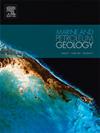Multistage dolomitization and fluid evolution of the late Ediacaran cap carbonates, Hormuz complex, Paskhand salt diapir, southern Iran: Insights into the dolomite problem
IF 3.7
2区 地球科学
Q1 GEOSCIENCES, MULTIDISCIPLINARY
引用次数: 0
Abstract
The Late Ediacaran to early Cambrian Hormuz dolomites were originally deposited on a shallow marine platform within the southern proto-Tethys Ocean, undergoing significant dolomitization during this period. The origins of different types of dolomites and their original fluids were studied in this work through petrological, mineralogical and geochemical data, including carbon, oxygen and clumped isotopes. The laminated micritic dolomite (LMD) (very finely to finely crystalline planar-e/s dolomite with preserving fabrics) and matrix dolomite (MD) including D1 (very finely to finely crystalline planar-e/s dolomite), the D2 (finely to medium crystalline planar-s/a dolomite) and D3 (medium to coarsely crystalline nonplanar-a dolomite) were precipitated from the combination of hydrothermal fluids and hydrologically cycled seawater in the subsurface to shallow burial stage. Fluctuation of the temperatures and changes in the characteristics of dolomitizing fluids formed different textures and distributions in the dolomites. Due to changes in temperature and Mg2⁺ concentrations in the hydrothermal fluids, the precipitation of cemented dolomite (CD1) and cemented dolomite (CD2 or SD) exhibited different textures and filling fracture system. In the final phase of hydrothermal alteration, late-stage calcite precipitates at low temperatures as a result of decreasing Mg2⁺ concentrations. Hydrothermal fluids, depleted in Mg2⁺ and enriched in silica, could result from the dissolution of siliciclastic sediments. The silica could be sourced from igneous rocks driven by the strongly extensional faults in the back-arc in Cadomian margin during the late Ediacaran time. The isotopic and petrographic analysis of the dolostones within the caprock of the Paskhand salt diapir indicate that their dolomitization occurred under hydrothermal and shallow burial conditions within the extensional back-arc Hormuz basin during late Ediacaran time. Dolomites exhibiting negative δ1³C values in the cap rock of the Paskhand salt diapir likely formed during the late Ediacaran period. This isotopic signature suggests that hydrothermal fluids interacted with organic-rich sediments, incorporating isotopically light carbon into the dolomite structure. This study provides new insights into the evolution of dolomitizing fluids responsible for multiple dolomitization events and the formation of hydrothermal dolomite in the Hormuz Basin and other regions worldwide.
求助全文
约1分钟内获得全文
求助全文
来源期刊

Marine and Petroleum Geology
地学-地球科学综合
CiteScore
8.80
自引率
14.30%
发文量
475
审稿时长
63 days
期刊介绍:
Marine and Petroleum Geology is the pre-eminent international forum for the exchange of multidisciplinary concepts, interpretations and techniques for all concerned with marine and petroleum geology in industry, government and academia. Rapid bimonthly publication allows early communications of papers or short communications to the geoscience community.
Marine and Petroleum Geology is essential reading for geologists, geophysicists and explorationists in industry, government and academia working in the following areas: marine geology; basin analysis and evaluation; organic geochemistry; reserve/resource estimation; seismic stratigraphy; thermal models of basic evolution; sedimentary geology; continental margins; geophysical interpretation; structural geology/tectonics; formation evaluation techniques; well logging.
 求助内容:
求助内容: 应助结果提醒方式:
应助结果提醒方式:


